I thought it might be a good idea to compile an online list of popular DDR3 ICs with known information.
Right now it is based mostly on my personal experience but I appreciate any educated contributions.
Before we begin, a couple of words on density:ElpidaDensity is one of the most important aspects of each individual IC.
It is usually measured in Gbit (gigabit) and represents the size of each memory chip that is on the module.
For example, if a particular IC has 1Gbit density then it takes 8 chips of 128MB (=1Gbit) each to build a 1GB module and 16 chips to build a 2GB module.
Known densities for DDR3 are: 512Mbit, 1Gbit, 2Gbit, 4Gbit. There are no desktop modules with IC density above 4Gbit and never will be.Note (credit to Don_Dan and ihog6hog)
Elpida chips can wear two types of labelling: full as seen here and partial as seen here.
In case of partial labelling:
- Fifth letter of the code translates into density. A for 1Gbit, V for 2Gbit and X for 4Gbit.
- Seventh letter of the code translates into the second letter in Elpida model. B for BBBG/BBSE, D for BDBG/BDSE and so on.
- Having xxBG or xxSE can be told from ICs having white stripes on IC sides. xxSE have stripes, xxBG don't.
1Gbit BASE (J1108BASE)
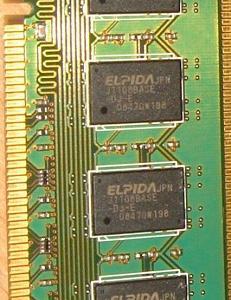
To be found on:
Very old 1333C9 and 1600C9 rated kits.
However, some 1600 7-8-7 Ripjaws (Elpida SNs made in 2009-early2010) and Corsair Dominator/GT 1600 7-8-7 (Ver2.1) kits are also based on these.
Benching relevance:
None.
How does it overclock:
Frequency wise, don't expect more than 900MHz.
800MHz is possible with 7-7-7 to 7-8-7 at 1.65V, depending on luck.
1Gbit BASE "Hyper"
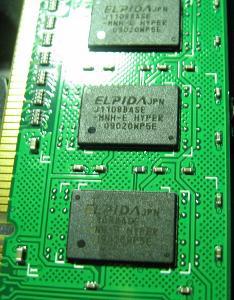
Came in two versions: MNH-E (produced around weeks 0850-0920) and MGH-E (produced around weeks 0920-0945).
The prior had random death issues and was recalled by some of the RAM manufacturers, but if your sticks are still alive today then there is nothing to worry about.
To be found on:
1600 6-6-6, 1866 7-8-7, 2000 7-8-7, 2000 8-8-8, 2133 8-8-8, 2200 8-8-8 and 2250 8-8-8 kits rated for 1.65V.
Benching relevance:
Sockets 775, 1155(SandyBridge), 1156, 1366 and AM3.
How does it overclock:
Given enough voltage (1.65-1.85V), will do 900-1000MHz with 6-6-6 and 1000-1100 7-7-7.
Scales linear from voltage up to 2.0V on air.
Tips:
On Sandy Bridge, some sticks cannot handle (immediate freeze under load) high bandwidth caused by high CPU speeds. Lowering CPU speeds might help with binning.
Binning criteria:
1) Voltage required for stability at 1000MHz 7-8-7. Rule of thumb: good kits will need 1.65V or less.
2) Ability to run tRCD along with the CAS latency (e.g. 6-6-6, 7-7-7) and not one value higher (e.g. 6-7-6, 7-8-7) without additional voltage.1Gbit BBBG and BBSE (J1108BBBG and J1108BBSE)
OEM codes: EBJ10UE8BBF0 for 1Gb modules, EBJ21UE8BBF0 for 2Gb modules.
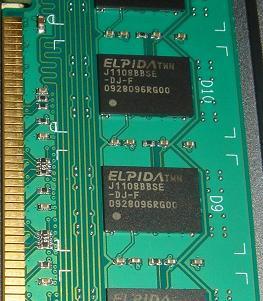
BBBG is a relatively rare type of IC, but it seems to be similar to BBSE.
To be found on:
Most 1600 7-7-7, 1866 8-8-8, 2000 9-9-9, 2133 8-9-8, 2133 9-9-9, 2200 9-9-9 kits rated for 1.65V.
Supposedly, Corsair ver2.2 kits.
Benching relevance:
Socket 1155.
How does it overclock:
tCL and tRP: Linear scaling from voltage (i.e. 1000 7-x-7 at 1.60V, 1100 7-x-7 at 1.76V and so on) up to 1.9V on air.
tRCD: Only scales from temperature. Typical limits at normal ambients are ~1150MHz tRCD 9 and ~1260MHz tRCD 10 and scaling is 1.0-1.2MHz per each degree centigrade.
Quality varies a lot, from kits that can't do 1000 7-9-7 (tWCL8) with any voltage to kits that can run 1100 6-9-6-20 (tWCL8) or 1300 8-11-7-22 (tWCL6) at 1.80-1.90V.
Tips:
From my experience, don't like subtimings too loose (Auto settings) and some kits don't like when you overshoot the voltage hoping for extra stability.
Lowering tWCL from 8 to 6 requires voltage bump similar to dropping CAS by one value, i.e. CL8+tWCL6 runs close on voltage to CL7+tWCL8, CL7+tWCL6 runs close on voltage to CL6+tWCL8.
Binning criteria:
1) MHz/volt relation using CL6(tWCL8) and CL7(tWCL8). Good kits should do 1100MHz CL6 under 1.85V and/or 1200MHz CL7 under 1.75V.
2) tRCD limits. Good kits should do 1150MHz+ tRCD 9 and 1275MHz+ tRCD 10 at normal ambients.
3) Ability to take high voltage (1.9V+) at 1300MHz+.1Gbit BDBG and BDSE (J1108BDBG and J1108BDSE)
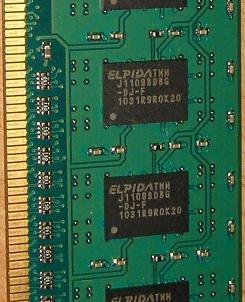
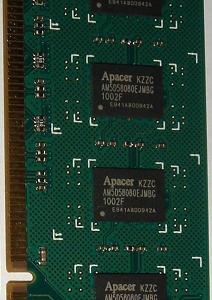
BDSE can be seen as a weaker (by ~50MHz) version of BDBG.
To be found on:
Some G.Skill and Kingston Elpida-1Gbit-based models from late2009 until mid 2010.
Kingston's 2250 9-11-9 and 2333 9-11-9 rated sets.
Supposedly, Corsair ver2.3 kits.
Benching relevance:
None, but can be "fun" under certain circumstances on LGA1155.
How does it overclock:
tCL and tRP: Linear scaling from voltage (i.e. 1000 7-x-7 at 1.60V, 1100 7-x-7 at 1.76V and so on) up to 1.9-2.0V on air.
tRCD: Only scales from temperature. Typical limits at normal ambients are ~1050MHz tRCD 9 and ~1150MHz tRCD 10 and scaling is 1.0-1.2MHz per each degree centigrade.
Quality varies a lot, from kits that can't do 1000 8-9-8 with any voltage to kits that can run 1100 6-9-6-24 or 1300 8-11-7-24 at 1.90V.
Binning criteria:
same as Powerchip 1Gbit X-series (below)1Gbit BFBG and BFSE (J1108BFBG and J1108BFSE)
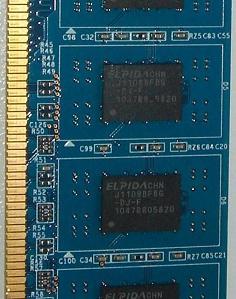
To be found on:
Some G.Skill and Kingston Elpida-1Gbit-based models from mid 2010 onwards.
Supposedly, Corsair ver2.4 kits.
Benching relevance:
None.
How does it overclock:
Roughly, like 1Gbit BDBG/BDSE minus 50-100MHz.
Most sticks will do 800MHz 7-8-7 and some will do do 1100MHz 9-12-10 at 1.65V.2Gbit BCBG and BCSE (J2108BCBG and J2108BCSE)
To be found on:
Kingston's Elpida-based 4GB modules made from early 2011 until mid-2012.
G.Skill's 4GB Trident modules rated for 1600 7-7-7 and 2000 9-9-9.
Corsair ver2.12
Benching relevance:
None.
How does it overclock:
Little is known, but I haven't seen verified BCBG/BCSE do much over G.Skill's rated 800MHz 7-7-7 or 1000MHz 9-9-9.2Gbit BDBG (J2108BDBG)
To be found on:
So far seen (verified) only on Kingston's 1333C9 and 1600C11 valuerams manufactured between late 2011 and now (early 2014).
Benching relevance:
None.
How does it overclock:
From what I've seen so far, these chips won't do more than 800MHz with 10-10-10.Hynix4Gbit BFBG
To be found on:
So far seen only on some Kingston valueram made in 2014.
Benching relevance:
None.
How does it overclock:
Unknown, but I would imagine that not too well.
1Gbit BFR (H5TQ1G83BFR)
To be found on:
Some of Kingston's 1333 7-7-7, 1600 8-8-8 and 1600 9-9-9 rated HyperX kits produced between late 2009 and mid 2010.
Corsair ver5.2
Benching relevance:
None.
How does it overclock:
The only kit I've had wouldn't run 32M at 933MHz with any timings or voltage, but some people managed to validate these ICs above 1400MHz with CL11 on air.2Gbit BFR (H5TQ2G83BFR)
OEM codes: HMT325U6BFR8C for 2Gb modules, HMT351U6BFR8C for 4Gb modules.
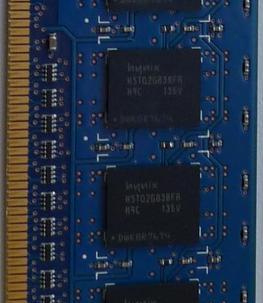
To be found on:
G.Skill 4GB modules rated for 1600 7-8-7 and most 1866+ models made in 2010 and 2011.
Kingston Hynix-2Gbit modules made before approx week 1205.
Corsair ver5.11.
Benching relevance:
None, but can be seen as a good daily alternative.
How does it overclock:
For fixed CL value, MHz/volt dependancy is just under linear. tRCD and tRP don't scale too well from voltage, 1.35 to 1.75V won't bring you more than 50MHz.
Don't seem to support stability much above 1200MHz even on high-rated mems. tRCD is best kept one value above tRP.
Quality varies, at 1.65V average samples will do 800MHz 7-8-7 and 1066MHz 9-11-10 while top stuff will do 1200MHz 9-11-10.2Gbit CFR (H5TQ2G83CFR)
OEM codes: HMT325U6CFR8C for 2Gb modules, HMT351U6CFR8C for 4Gb modules.
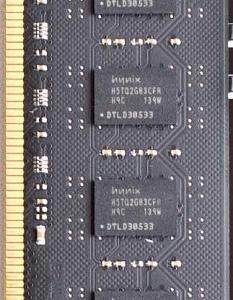
To be found on:
G.Skill: 4GB modules rated 2133 9-11-10 made after week 1210, 2400 10-12-12 kits with "Hynix SN", 2666 11-13-13 and 2800 12-14-14 kits made before mid2013 and 2800C11 rated kits.
Some 4GB modules rated 2133 10-12-12 and 2400 11-13-13.
Kingston Hynix-2Gbit modules made after week 1210.
Corsair ver5.12.
Benching relevance:
None, but can be seen as an alternative for daily usage and raw frequency suicide screens.
How does it overclock:
For fixed CL value, MHz/volt dependancy is just under linear. tRCD and tRP don't scale too well from voltage, 1.35 to 1.75V won't bring you more than 50MHz.
tRCD is best kept one or two value above tRP.
Quality varies, bad ones will need 1.75V+ for 1100MHz 9-12-10, 1200MHz 10-13-11 and 1300MHz 11-14-13 while really good ones should do 1300MHz 10-12-11 and 1400MHz 11-13-12 under 1.65V.
Binning criteria:
1) Voltage required for stability at 1400MHz CL11. Rule of thumb: good kits will need under 1.65V.
2) Ability to run tRCD 13 and/or tRP 12 at 1400MHz.2Gbit EFR (H5TQ2G83EFR)
Haven't seen these in the wild, but "some say" that these will do 800MHz 8-8-8 at best and will struggle to reach higher speeds.4Gbit MFR (H5TC4G83MFR and H5TQ4G83MFR)
OEM codes: HMT41GU6MFR8A and HMT41GU6MFR8C for 1.35/1.50V 8Gb modules.
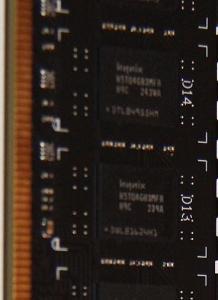
To be found on:
Nearly all 4GB modules rated 2666 11-13-13 and 2800 12-14-14 produced after mid-2013. All 4GB modules rated 2933 and above. All 8GB modules rated 2600 and above.
Some single-sided 4GB and dual-sided 8GB modules rated 2133 10-12-12 and 2400 11-13-13.
Kingston's 8GB modules rated 2133C11 and 2400C11. Corsair ver5.29.
Benching relevance:
4GB modules are only good for raw freq suicide screens.
8GB modules can be good for high-frequency high-density daily use.
How does it overclock:
For fixed CL value, MHz/volt dependancy is just under linear. tRCD and tRP don't scale too well from voltage, 1.35 to 1.75V won't bring you more than 50MHz.
tRCD is best kept one value above tRP or same as tRP.
Need tRFC of 300 and above to be able to run high frequencies.
Samples of average quality should do 1100MHz 9-11-10, 1200MHz 10-12-11 and 1300MHz 11-13-12 at 1.65V.
Binning criteria:
1) Voltage required for stability at 1400MHz CL11. Rule of thumb: good kits will need under 1.65V.
2) Ability to run tRCD 13 and/or tRP 13 at 1400MHz.4Gbit AFR (H5TC4G83AFR and H5TQ4G83AFR)
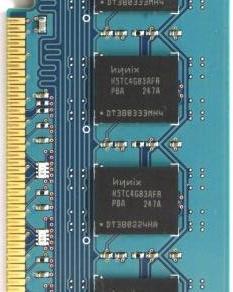
Despite the alphabetical misorder, this model is newer than 4Gbit MFR.
To be found on:
Kingston 1333 and 1600-rated Hynix memory produced after week 1310.
Supposedly, Corsair ver5.21
Benching relevance:
None.
How does it overclock:
For fixed CL value, MHz/volt dependancy is just under linear. tRCD and tRP don't scale too well from voltage, 1.35 to 1.75V won't bring you more than 50MHz.
Need tRFC of 300 and above to be able to run high frequencies.
Samples of average quality should do 1100MHz 10-11-10 or 1200MHz 11-13-12.Micron4Gbit BFR (H5TC4G83BFR and H5TQ4G83BFR)
To be found on:
Only seen on Kingston 1866 9-10-11 rated modules so far.
Benching relevance:
Has potential to be good for raw frequency results.
How does it overclock:
For fixed CL value, stable frequency scales well from voltage, but not linear. Lowest tRCD and tRP depend mainly on frequency, then voltage: 1.35V to 1.75V can yield around 100MHz for a fixed tRP.
Need tRFC of 300 and above to be able to run high frequencies. Compared to all other ICs, need very high tRP.
Samples of average quality should do 1200MHz 10-12-13, 1300MHz 11-13-14 and 1400MHz 12-14-16.
1Gbit D9GTN, D9GTR and D9GTS
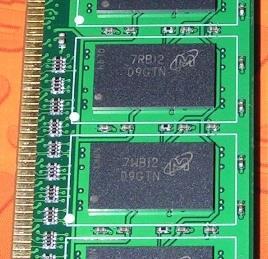
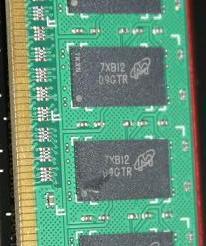
Despite what some people say, these are the same IC with different JEDEC bins hence these should overclock the same.
To be found on:
Cellshock kits rated 1600 7-6-5 and 1800 8-7-6.
Corsair ver3.1 modules rated 1.8V and above.
Crucial Ballistix kits rated 1333 6-6-6, 1600 8-8-8 1.8V and 2000 9-9-9.
CSX Diablo 2000 8-7-6.
Some of Mushkin's and OCZ's kits rated for 1600 7-7-x and 1800 8-8-x at 1.8V+.
Benching relevance:
Socket 775.
How does it overclock:
Linear voltage scaling up to ~2.2V on air.
Decent kits will do 900MHz 6-6-5 and 1000MHz 7-6-6 at 2.2V.
Binning criteria:
Voltage required for stability at 800MHz 6-6-5 and 900MHz 7-6-6. Rule of thumb: good kits will need under 2.0V for both.1Gbit D9JNL and D9JNM
To be found on:
Cellshock 1866 8-8-8 modules.
Corsair ver3.2 modules rated 1.8V and above.
Some of Mushkin's and OCZ's kits rated for 1600 7-7-x and 1800 8-8-x at 1.8V+.
Benching relevance:
None.
How does it overclock:
Have linear voltage scaling up to 2.0-2.2V on air, but above 1.8-1.9V doesn't gain stability.
Don't like CL6 or tight subtimings at all. CL9 doesn't seem to give improvement over CL8.
Decent kits will do 900MHz 7-7-7 and 1000MHz 8-8-8 at 1.8V.1Gbit D9KPT and D9KPV
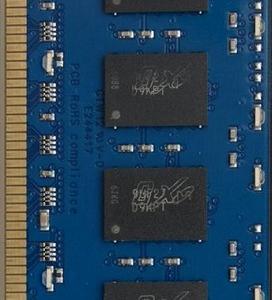
To be found on:
Crucial Ballistix 1333 7-7-7 and 1600 8-8-8 modules rated 1.65V.
Corsair 1600 7-7-7 kits rated 1.65V of version 3.1.
Some of OCZ Blade 2000 9-9-9 kits.
Benching relevance:
None.
How does it overclock:
Seem to overclock much like D9JNx above but also benefit from CL9 and good kits can do 1000MHz 9-9-9 under 1.7V.2Gbit D9LGK and D9MNL
To be found on:
Various Micron-based kits from 2010-2011 rated between 1333 9-9-9 and 1600 9-9-9.
Benching relevance:
None.
How does it overclock:
Have never seen either of these do more than 800MHz 9-9-9.2Gbit D9PFJ
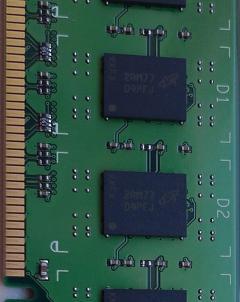
To be found on:
Some Crucial Ballistix Elite kits rated 1333 7-7-7, 1600 8-8-8 and 1866 9-9-9.
Some of Kingston's 1600 9-9-9 HyperX made in 2012-2013.
Benching relevance:
None.
How does it overclock:
Overclock best using even single-digit primary timings, scale very well from voltage. 4Gb modules have problems doing above 1066MHz stable.
Quality varies a lot, worst ones won't do 900MHz 8-8-8 or 1000MHz 9-9-9 at any voltage, good stuff will do 900MHz 7-7-7 and 1000MHz 8-8-8 at 1.75V and keep scaling.4Gbit D9QBJ
To be found on:
Recent Crucial Ballistix kits rated 1600 8-8-8 and 1866 9-9-9.
Corsair's 4GB 2133C8 modules. Possibly on 2133C9, 2400C10 and lower specs as well.
Benching relevance:
None.
How does it overclock:
Overclock best using even single-digit primary timings, scale very well from voltage. 8Gb modules have problems doing above 1200MHz stable.
Seem to perform best when tRCD is equal to CAS or CAS+1 and tRP is between CAS+1 to CAS+3.
Quality varies a lot, best sticks will do 1066MHz 7-8-10 and 1200MHz 8-9-11 at 1.80V and keep scaling.Powerchip (PSC)2Gbit/4Gbit D9Pxx/Qxx
Micron also has other ICs such as D9PSH, D9QMS but I haven't yet been able to systematise the information.
My personal claim (yet unproven):
Second and third letters might indicate production week. For example, difference between XDS and XDV would be three weeks.
Basis for this would be existence of XB-marked DDR2 modules in early2008, first appearance of XE- in mid2009, XF- in late2009/early2010, TG- in mid2010, TH- in late2010 and so on ... i.e. roughly a 26 week cycle for each second letter.1Gbit X-series
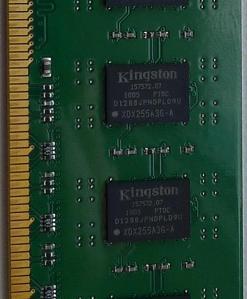
1Gbit PSC chips, marking of which starts with a letter "X", have identical overclocking properties, so those should be the same.
My guess that the subversions A3G-A (most common), A3G-P (with stripes on sides like on Elpida B_SE) and the like indicate different JEDEC bins.
To be found on:
All 1GB/2GB modules rated 2000 6-9-6, 2133+ CL7, 2300+ CL8 and 2400 9-11-9.
Some Corsair ver7.1 modules.
Some G.Skill 1600 7-8-7 and 1600 8-8-8 rated kits with "PSC serial number" made before approx week 1020.
Some Kingston 1066C7 and 1333C9 valueram procudec between late 2009 and mid-2010.
Mushkin 2GB modules rated 1600 6-8-6 and 2000 7-10-8, also some 2GB modules rated 1600 7-8-7.
Benching relevance:
Sockets 1155, 1150 and 2011.
How does it overclock:
tCL: Linear scaling from voltage (i.e. 1000 7-x-x at 1.50V, 1100 7-x-x at 1.65V and so on) up to 1.90-1.95V on air.
tRCD: Only scales from temperature at around 1.0-1.2MHz per each degree centigrate. Typical limits at normal ambients are 1000-1066MHz tRCD 9, 1150-1200MHz tRCD 10 and 1250-1300MHz tRCD 11.
tRP: Can usually run same value as CAS, but some kits might require it raised by one or two values. This will get worse as memory frequency increases.
tRAS: Base value would be 28 for 1200-1333MHz on air cooling. Might need to be further raised by two values each ~50MHz.
Quality varies, from kits that can do 1300MHz 7-11-7 (tWCL8) under 1.75V to ones that won't do 1200MHz 7-11-10 (tWCL8) with any voltage.
Tips:
Lowering tWCL from 8 to 6 requires voltage bump similar to dropping CAS by one value, i.e. CL8+tWCL6 runs close on voltage to CL7+tWCL8, CL7+tWCL6 runs close on voltage to CL6+tWCL8. Therefore, people usually confuse/underestimate CL7+tWCL6 runs for CL7+tWCL8 runs which are about 15% apart in terms of stable voltage.
When running 1333MHz+ on Haswell, some kits experience so-called frequency-dependant voltage holes. For example, a kit can run settings X at 1.78-1.80V and 1.85V+ all day long but 1.81-1.84 will have severe stability issues for no apparent reason.
Binning criteria:
1) MHz/volt relation using CL6(tWCL8) and CL7(tWCL8). Interesting kits start from under 1.7V for 1200MHz CL7. Good kits start from under 1.65V for 1200MHz CL7 and under 1.85V for 1200MHz CL6. To put things into perspective, 1.65V for 1200MHz CL7 tWCL8 with linear scaling would imply ~1.83V for 1333MHz CL7 tWCL8 so same kit should be expected to run 1333MHz CL8 tWCL6 with moderately tight subtimings around 1.85V.
2) tRCD limits. Good kits can at least boot 1200MHz tRCD 10 and 1300MHz tRCD 11 at normal ambients.
3) Capability of running tRP same as CL throughout the whole stable frequency range between 1100 and 1350MHz.1Gbit R-series and T-series
1Gbit PSC chips, marking of which starts with a letter "T", have identical overclocking properties, so those should be the same.
My guess that the subversions A3G-A (most common), A3G-P (with stripes on sides like on Elpida B_SE) and the like indicate different JEDEC bins.
To be found on:
Some G.Skill 2GB modules rated 1600 6-8-6, 1600 7-8-7, 1600 8-8-8 modules with "PSC serial number" produced after week 1020.
Some G.Skill 2GB modules rated 2133 9-11-9 and 2200 9-11-9.
Some Kingston 1066C7 and 1333C9 valueram modules made from mid to late 2010.
Benching relevance:
None.
How does it overclock:
tCL: Linear scaling from voltage (i.e. 1000 8-x-x at 1.60V, 1100 8-x-x at 1.76V and so on) up to about 1.9V on air.
tRCD: Only scales from temperature. Typical limits are around 100MHz or roughly one value lower than for X-series.
tRP: Can usually run same value as CAS, but some kits might require it raised by one or two values. This will get worse as memory frequency increases.
tRAS: Base value would be 28 for ~1200. Running higher frequencies (when possible) will need a further increase.2Gbit
2Gbit chips from Powerchip have similar markings, but I haven't yet figured out any systematic difference between 2Gbit ones starting with R,T or X.
To be found on:
G.Skill 4GB modules with "PSC serial number".
Some Kingston valueram modules made between early 2011 and late 2012.
Benching relevance:
None.
How does it overclock:
Don't seem to scale from voltage at all. Best you could expect would be 800MHz 9-8-7 and 933MHz 10-9-8.Samsung4Gbit
4Gbit chips from Powerchip have similar markings, but I haven't yet figured out any systematic difference between 2Gbit ones starting with R,T or X.
To be found on:
G.Skill 8GB modules with "PSC serial number".
Benching relevance:
None.
How does it overclock:
Don't seem to scale from voltage at all. Best you could expect would be 800MHz 9-9-9.Common mistake:
Many people identify Samsung ICs by their spec.codes, like "HCF0" for 1Gbit D-rev or "HCH9" for 2Gbit D-rev.
In reality, the spec.code only indicates JEDEC specs of a particular model of a particular version.1Gbit revision D (K4B1G0846D)
OEM code: M378B5673DZ1 for 2GB modules

To be found on:
Some 1.8V+ rated kits with specs of 1800 9-9-9, 1866 9-9-9 or 2000 9-9-9 and 1.65V rated 2000 9-9-9 kits from late 2008 - early 2009.
Kingston also used these on 1800 8-8-8 HyperX sets manufactured in late 2008 - early 2009.
Corsair ver4.1
Benching relevance:
None.
How does it overclock:
Can scale up to ~2.0V, at 1.8V decent kits can do 1000MHz 8-9-8 and 1100MHz 9-9-9.2Gbit revision C (K4B2G0846C)
OEM codes: M378B5773CH0 for 2GB modules, M378B5273CH0 for 4GB modules
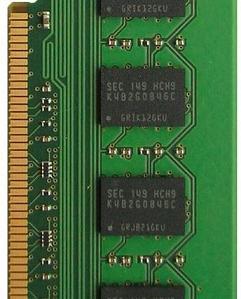
To be found on:
Only seen on OEM modules so far.
Benching relevance:
None, but can be seen as a budget daily alternative.
How does it overclock:
CL: Near linear scaling from voltage (i.e. 1000 9-x-x at 1.50V, 1100 9-x-x at 1.65V and so on) up to about 1.8V on air.
tRCD and tRP: Usually best ran equal, at 1-2 values above CAS. Scale from voltage and temperature, but nowhere near as well as CL does.
Typical overclock would be 1066MHz 9-10-10 and 1200MHz 10-11-11 at 1.65V.2Gbit revision D (K4B2G0846D)
OEM codes: M378B5773DH0 for 2GB modules, M378B5273DH0 for 4GB modules
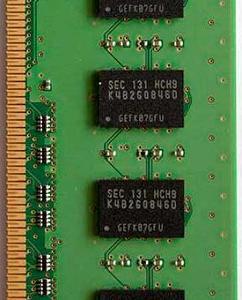
To be found on:
Any 4GB modules rated for 2133 CL9 at 1.5V, 2400 9-11-11, 2600 10-12-12 and 2666 10-12-12.
Corsair ver4.13
Benching relevance:
Sockets 1155, 1150 and 2011.
How does it overclock:
CL: Near linear scaling from voltage (i.e. 1000 8-x-x at 1.50V, 1100 8-x-x at 1.65V and so on) up to 2.0-2.3V (depending on PCB) on air.
tRCD and tRP: Usually best ran equal, at 1-2 values above CAS. Scale from voltage and temperature, but nowhere near as well as CL does. x-11-11-x usually maxes out at 1250-1333MHz, x-12-12-x maxes out around 1350-1450MHz.
Average samples should do 1200MHz 9-11-11 and 1300MHz 10-12-12 at 1.65V, while really good stuff will do 1400MHz 10-12-12 under 1.65V and 1400MHz 9-12-12 under 1.95V.
Binning criteria:
1) MHz/volt relation using CL9 and CL10. Good kits should do 1400MHz CL9 under 2.0V and 1400MHz CL10 under 1.7V.
2) tRCD limits. A good kit on this matter can run Spi 32M at 1300 x-11-11 and 1400 x-12-12 at voltages under 1.75V.2Gbit revision E (K4B2G0846E)
OEM codes: M378B5773EB0 for 2GB modules, M378B5273EB0 for 4GB modules
To be found on:
Only seen verified on OEM modules so far. However, some 2013-made dual-sided 4GB G.Skill 2400 10-12-12 modules might be based on these.
Benching relevance:
None.
How does it overclock:
CL: Near linear scaling from voltage (i.e. 1000 9-x-x at 1.50V, 1100 9-x-x at 1.65V and so on) up to about 1.8V on air.
tRCD and tRP: Usually best ran equal, at 1-2 values above CAS. Scale from voltage and temperature, but nowhere near as well as CL does.
An average set would do 1200MHz 10-12-12 at 1.6V but not much more.4Gbit revision B (K4B4G0846B)
OEM codes: M378B5173BH0 for 4GB modules, M378B1G73BH0 for 8GB modules


To be found on:
Most single-sided 4GB and dual-sided 8GB modules rated 1600 7-8-8, 1866 8-9-9, 2133 9-11-11 and 2400 10-12-12.
Some 8GB modules rated 2400 11-13-13.
Benching relevance:
None, but can be seen as a decent daily alternative.
How does it overclock:
CL: Near linear scaling from voltage (i.e. 1000 9-x-x at 1.50V, 1100 9-x-x at 1.65V and so on) up to about 1.8V on air.
tRCD and tRP: Do not scale from voltage or temperature at all. tRCD is best ran equal or one value above tCL. tRP is best ran two values above tCL.
Like most 4Gbit ICs, need tRFC around 300 to be able to run high frequencies.
Most sets will struggle to run above 1250MHz and almost no set will run 1300MHz. However, most sets will run 1066MHz 9-9-11 and 1200MHz 10-10-12 at 1.65V.4Gbit revision C (K4B4G0846C)
OEM codes: M378B5173CB0 for 4GB modules, M378B1G73CB0 for 8GB modules
So far I have only seen these on OEM modules and have no idea how well they overclock.4Gbit revision D (K4B4G0846D)
OEM codes: M378B5173DB0 for 4GB modules, M378B1G73DB0 for 8GB modules
To be found on:
Only seen on OEM modules so far.
Benching relevance:
None.
How does it overclock:
CL: Near linear scaling from voltage (i.e. 1000 10-x-x at 1.50V, 1100 10-x-x at 1.65V and so on).
tRCD and tRP: Do not scale from voltage or temperature at all. tRCD is best ran at ~2 values above CL, tRP is best ran same value as CL.
The modules that I had would not run 24/7 stable much past 1100 11-12-11 under 1.65V.4Gbit revision Q (K4B4G0846Q)
OEM codes: M378B5173QH0 for 4GB modules, M378B1G73QH0 for 8GB modules
To be found on:
Only seen on OEM modules so far.
Benching relevance:
None.
How does it overclock:
CL: Near linear scaling from voltage (i.e. 1000 9-x-x at 1.60V, 1100 9-x-x at 1.76V and so on) up to about 1.8V on air.
tRCD and tRP: Do not scale from voltage or temperature at all. tRCD is best ran at 2-3 values above CL, tRP is best ran one value below tRCD.
Like most 4Gbit ICs, need tRFC around 300 to be able to run high frequencies.
Average samples can do 1066MHz 9-11-10 and 1200MHz 10-12-11 at 1.65V.






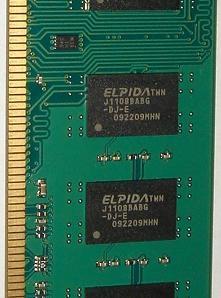
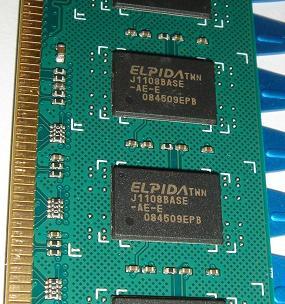





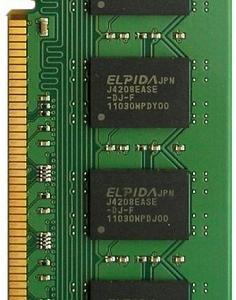


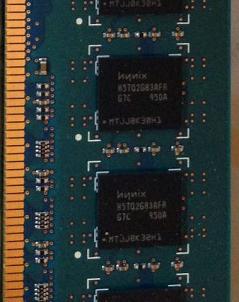
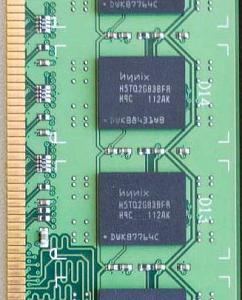
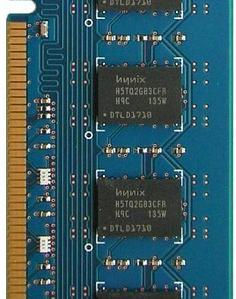




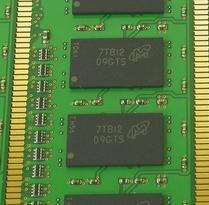



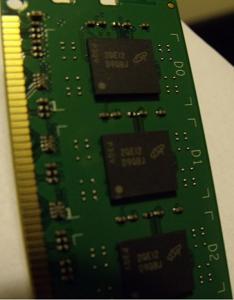

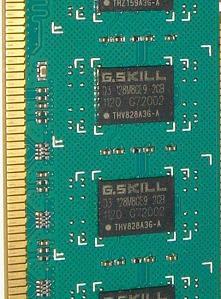

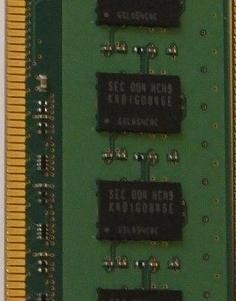


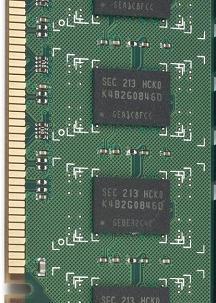
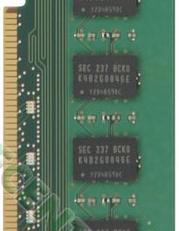

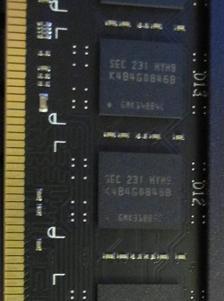
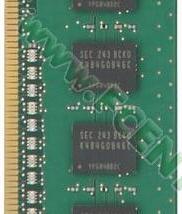
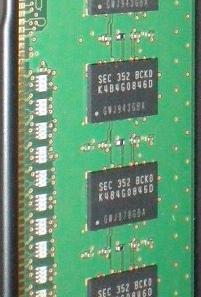
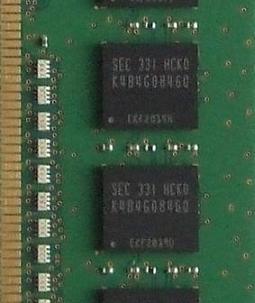

 Reply With Quote
Reply With Quote

Bookmarks